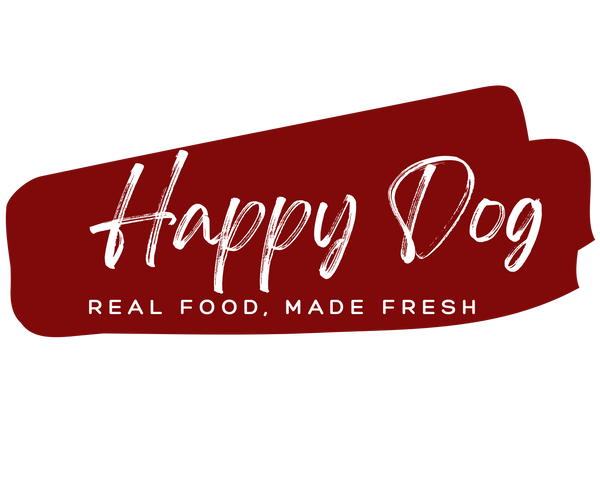
Is a Raw Food Diet Right for Your Dog?
To those customers who care enough to assess the risks and needs of placing their beloved canine on a raw diet, this page has been created to assess the benefits and hazards; as well as workarounds for those hazards, in order to make an informed decision.
Happy Dog Food is proud to offer all natural dog food for your canine. Your dog deserves to feel its best -- naturally!
Benefits
Putting your dog on a consistent diet of raw food will lead to developing a canine that exhibits a uniform level of improvement over one that subsists on kibble and treats.- Avoiding Melamine: Melamine is a compound that necessitated a massive recall within the commercial dog food industry back in 2007. This substance can result in the growth of crystals in the kidneys to the point that the flow of urine reduces or becomes completely blocked. By placing your dog on a raw food diet, you spare it any potential chance of exposure to this chemical and costly bills from your veterinarian.
- More Energy: Several common ingredients of mainline dog foods work together to dilute your dog's regular level of energy.
- Reduction in Stool Size: This benefit dovetails off of the increased level of energy your dog will exhibit. As a raw diet is devoid of the chemical and/or processed ingredients that eventually pass through the entirety of your dog's excretory system, less mass is produced when your dog needs to relieve itself.
- Shinier Coat.
- Healthier Skin.
- Cleaner Teeth.
Precautions
Just like the humans who decide to eat healthier, a raw diet for dogs also carries a higher price tag than basic kibble and treats. However, pricier food is a small price to pay when compared to costly bills from your veterinarian for health issues that can be reduced, if not eliminated, by placing your canine on such a meal plan. Beyond any issues with pricing, there are several medical precautions that must be taken into account with a raw diet for canines.- Meat: Raw meat carries the risk of transmitting E. coli, Listeria, Salmonella, Shigella, Staphylococcus aureus and campylobacter to name just a few. This issue also runs the risk of passing such infections on to humans through something as innocent as lapping at a scraped knee.
- Bone: Related to, yet separate from, any issues with raw meat, complete bones have the potential to either damage crucial teeth or become stuck in the dog's throat, causing trouble with breathing. Beyond whole bones, jagged bone fragments run the risk of cutting into your dog's insides and causing internal bleeding.
- Balance: Regardless of the diet you choose to place upon a pet, it is important to check that you can cover all of the nutritional needs of your particular breed.
- Research the necessary daily requirements of vitamins and minerals for your dog's size, age and breed. Also be aware of any dietary allergies your dog may have.
- Minimize the size/frequency of bones consumed.
- Minimize bacterial hazards by purchasing raw meat that has been freeze-dried or frozen.
Fun Fact
The reason that bones are regarded as a favorite food of dogs comes from the delicious marrow inside their core. Bone marrow is also quite palatable to humans after a quarter hour in the oven at 400 F and the application of a little salt and pepper.Happy Dog Food is proud to offer all natural dog food for your canine. Your dog deserves to feel its best -- naturally!
